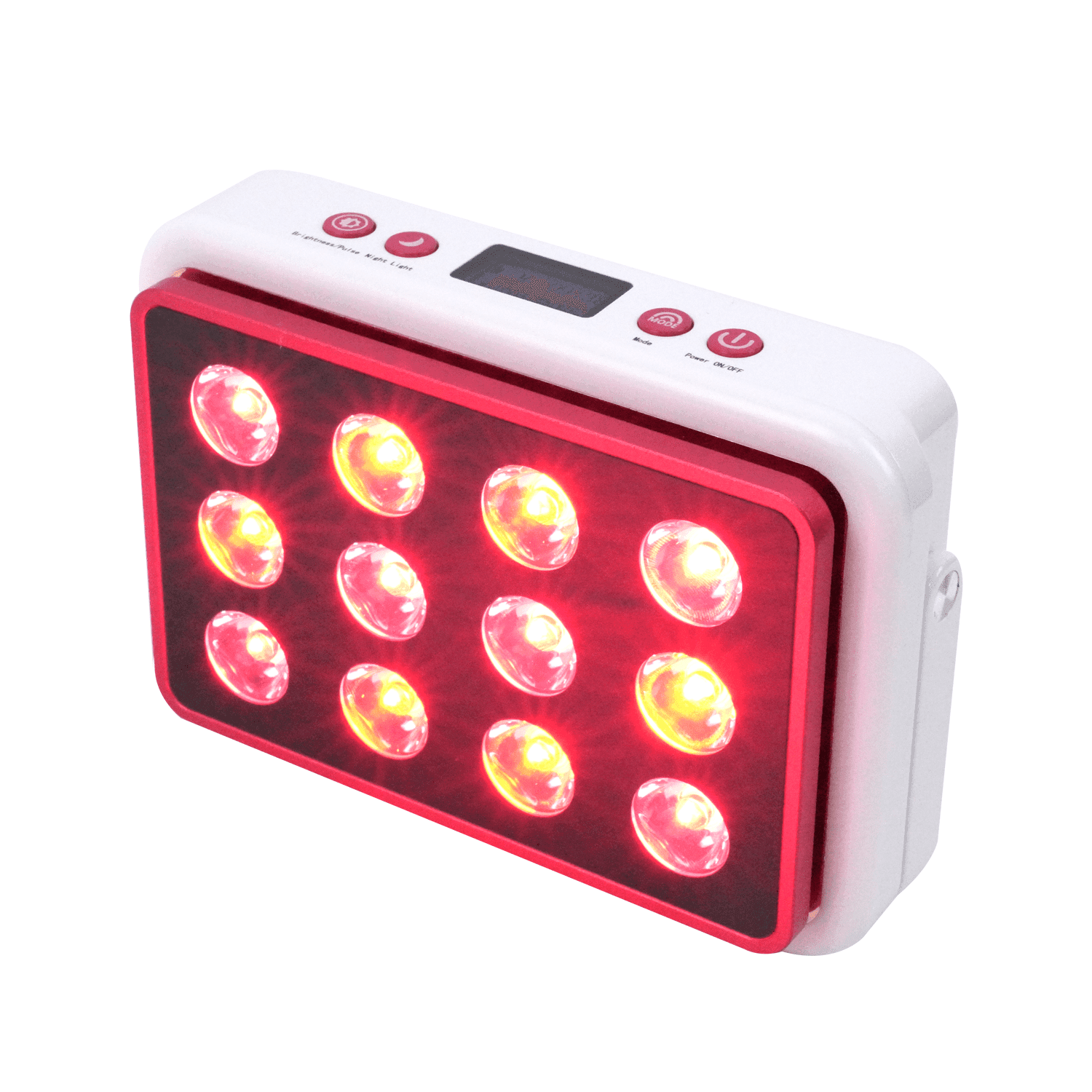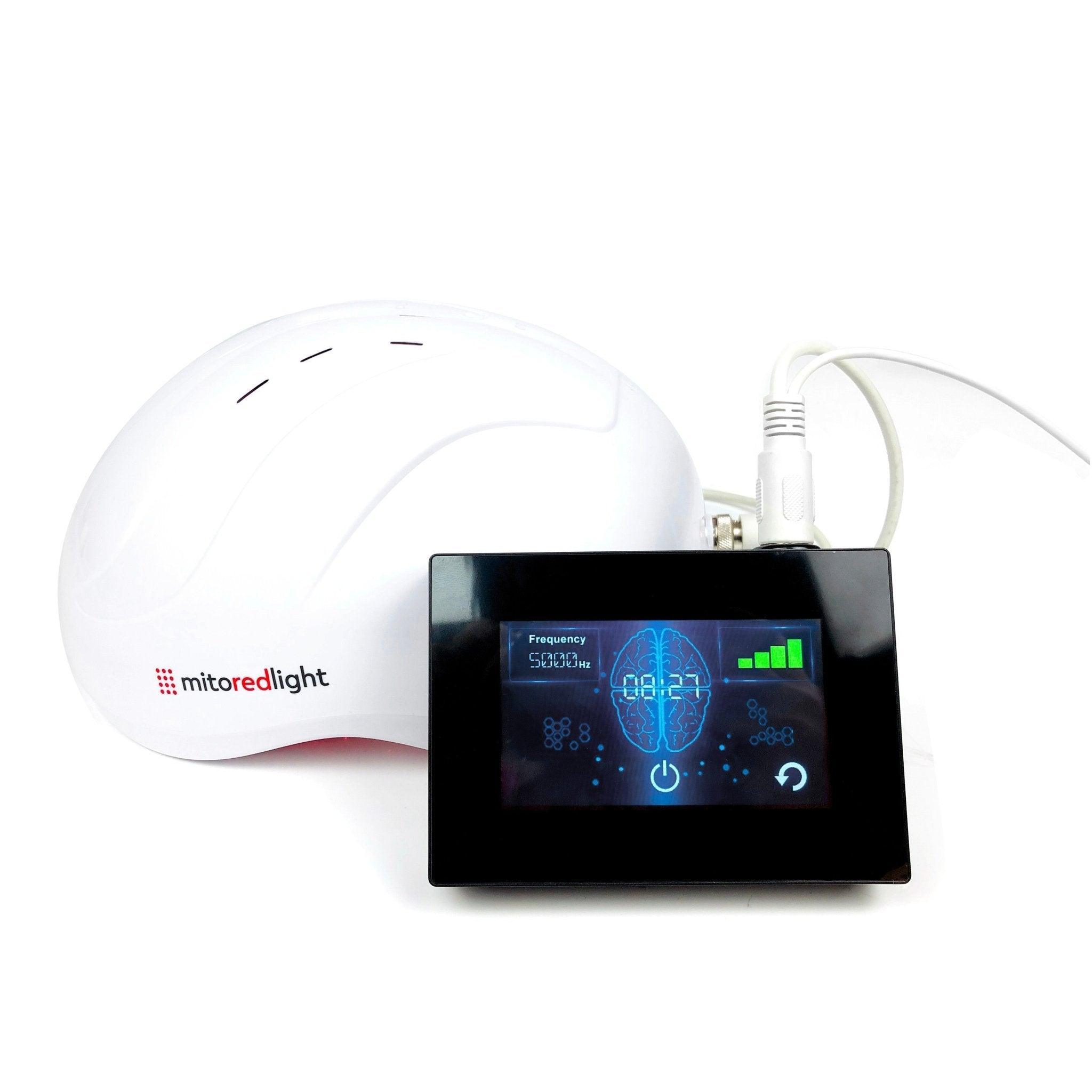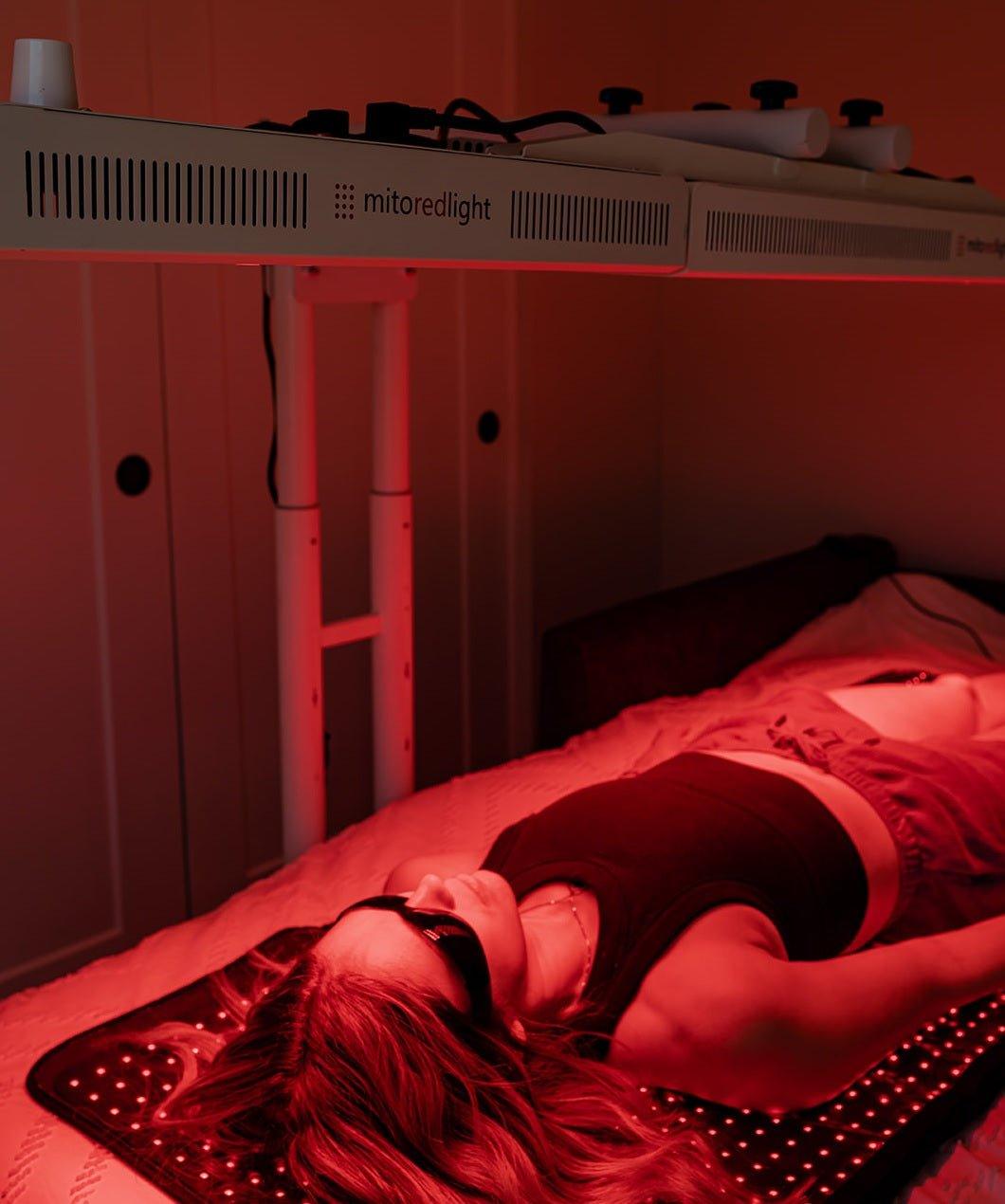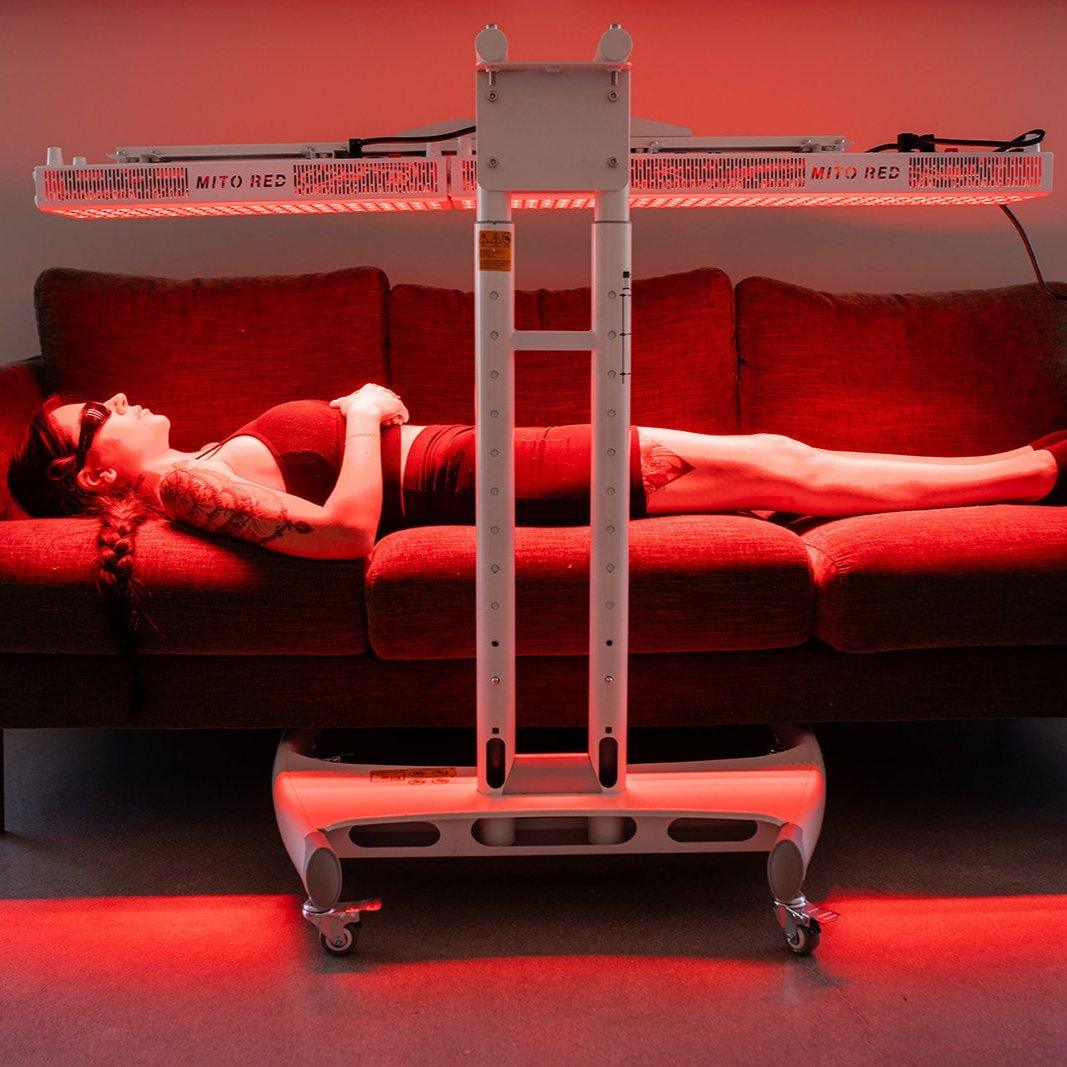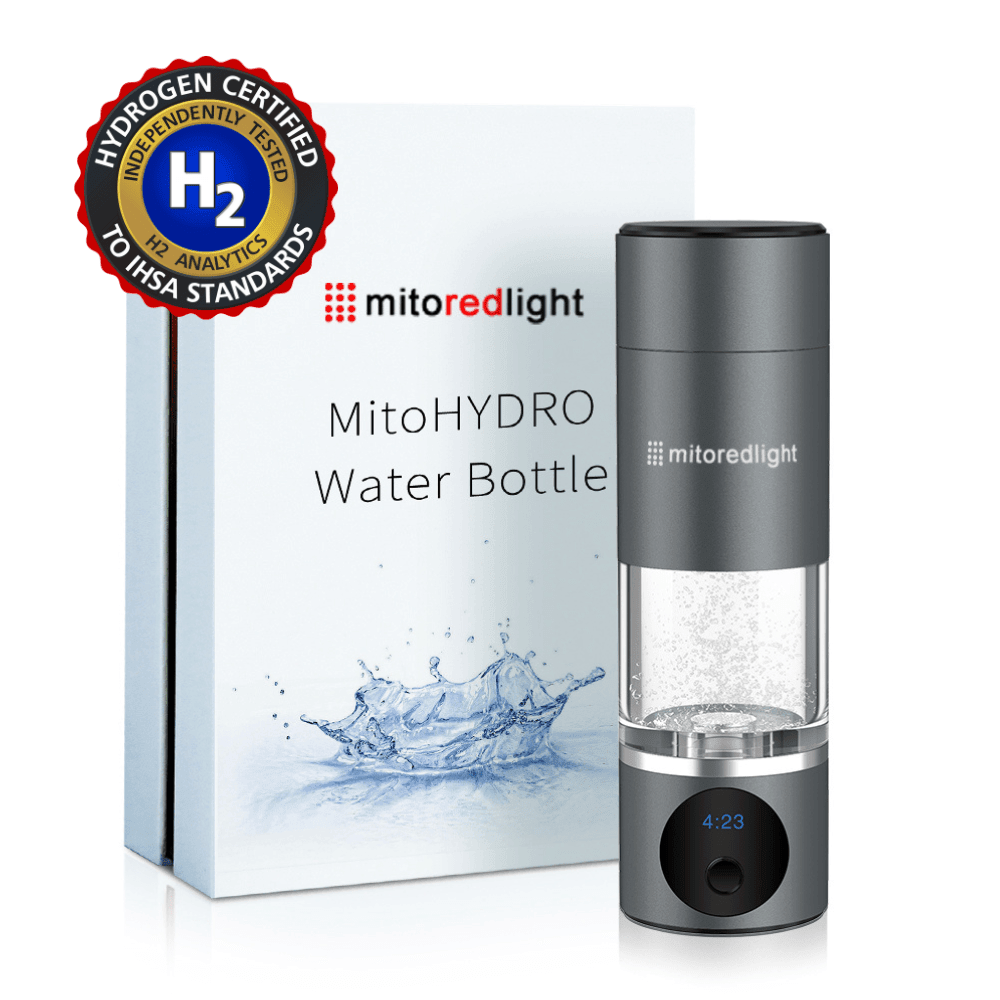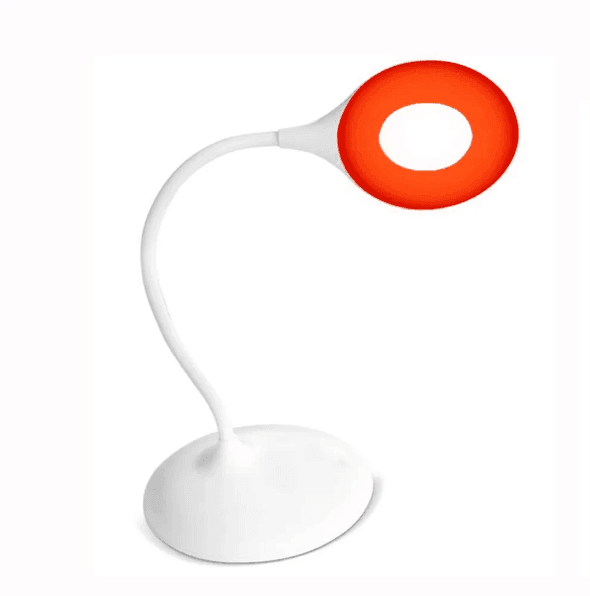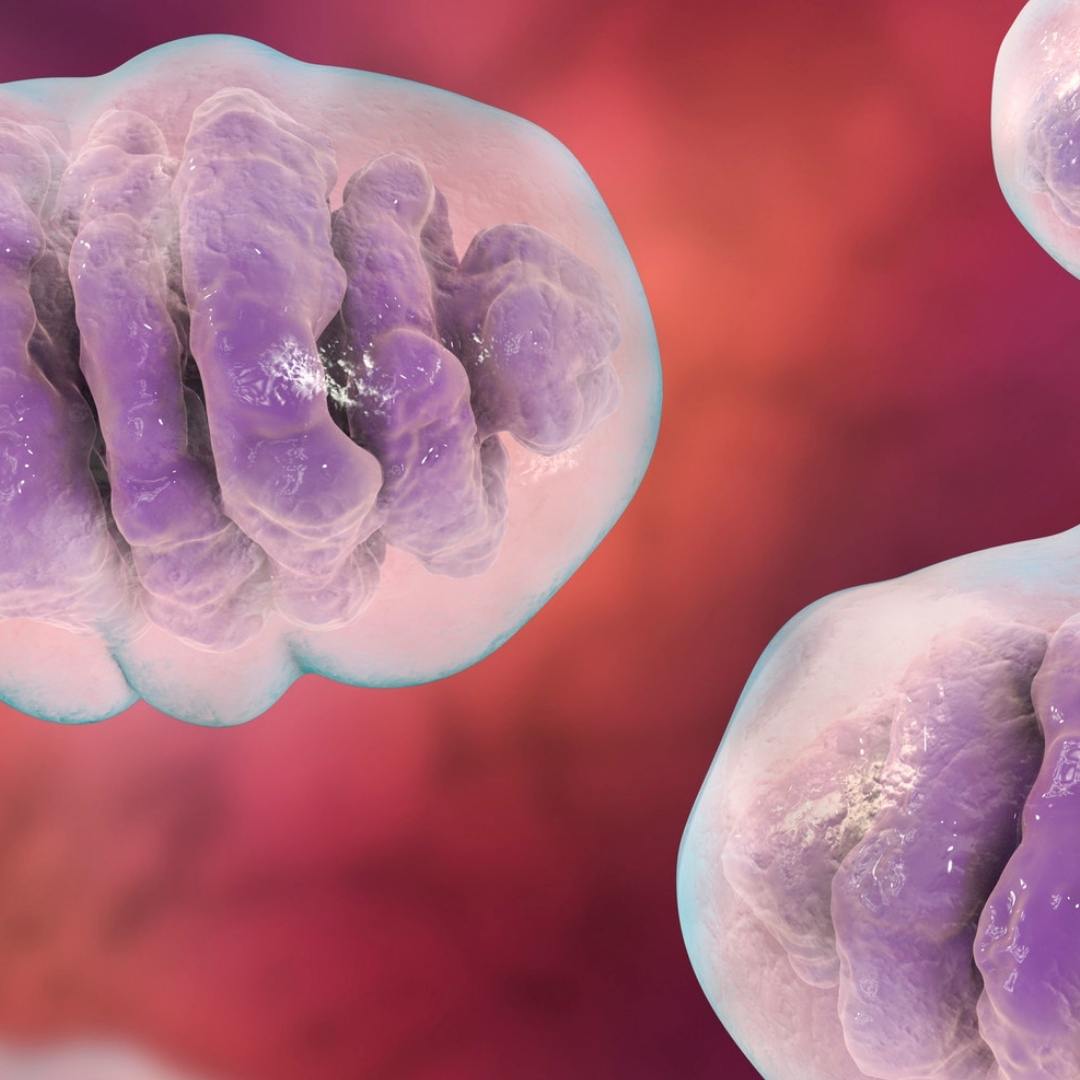DISCLAIMER: Mito Red Light devices are Class II wellness devices aimed at affecting the body through topical heating and supporting cellular function. The information provided in this article and on this site is for educational purposes only and is not intended to imply effectiveness of Mito Red Light devices for any specific application. The information provided in this article and on this site is not intended to diagnose, treat, cure, or prevent any disease, is not a substitute for consultation with a licensed medical provider and should not be construed as medical advice. Click here to read our article on potential contraindications of red light therapy..
Have you ever stepped on the scale after dieting for a few weeks or working out, only to be met with disappointment? Weight loss can seem like a slow, difficult process, frustrating many. To support their weight loss efforts, many people are turning to the benefits red light therapy offers.
Red light therapy has emerged as a promising option that has garnered significant attention in recent years. It has gained popularity for its potential to improve skin conditions, reduce inflammation, and promote overall wellness. But did you know that it can also play a role in weight loss?
In this article, we’ll dive deep into the science of excess weight while also exploring the benefits of red light therapy and its role in weight loss. By the end, you’ll have a deep understanding of what causes excess weight, the scientifically-proven approaches you can use to lose weight, and how people are using red light therapy to support their weight loss efforts.
What Causes Weight Gain?
Understanding what causes weight gain [1] is essential for losing weight. There are many different elements involved in weight gain, all of which must be considered and addressed if you are serious about losing weight. By understanding the causes of weight gain, you will be better equipped to reach your goal weight as quickly as possible.
Fat: What is It?
Fat, also known as adipose tissue, primarily consists of a type of cell called an adipocyte. Adipocytes store energy in the form of lipids (fat molecules), which serve as a reserve for your body to use when it needs extra energy.
There are two primary types of fat in the human body: subcutaneous and visceral fat. Subcutaneous fat lies just beneath the skin and is the most visible form of fat. It provides insulation and protection to your body while also serving as an energy reserve. Visceral fat [2], on the other hand, surrounds your internal organs and has a more significant impact on overall health. Excessive visceral fat can lead to many different health issues and is the most harmful form of fat.
Fat plays a vital role in maintaining your body's overall health, acting as a cushion for our organs, regulating hormones, maintaining warmth, and providing a source of energy. However, an excess of fat, especially visceral fat, can be detrimental to your health. As you burn more energy than you eat, your body will naturally begin to use the stored energy found in adipocytes, reducing the volume of fat in your body and making you lose weight.
Energy Imbalance
At its core, the scientific aspects of weight gain or loss is relatively simple. Weight is stored energy and accumulates when you take more energy in than you expend. Your energy intake comes in the form of what you eat or drink, and the energy you expend is burned whenever you engage in physical activity. Your body is constantly burning energy, even when you are asleep; however, the more active you are, the more energy you’ll burn.
Energy used by the body is measured in calories. According to the Dietary Guidelines for Americans 2020-2025 [3], the average amount of calories used each day is 1600-2400 calories for the average adult woman and 2000-3000 calories for the average adult man.
Daily calorie usage varies significantly between individuals based on several factors:
- Age - The older you are, the fewer calories you tend to burn in a day.
- Activity - The more active you are, the more calories you will use.
- Body size - The larger you are, the more calories you tend to burn.
- Body composition - The more your body consists of cells that burn energy faster, like muscle cells, the more calories you tend to burn.
There are many online calculators [4] that can give you an idea of how much energy you’ll burn during an average day; however, a doctor or nutritionist can provide you with the most accurate information about your daily energy needs.
Disease
While energy imbalance is the core factor behind weight gain or loss, there are many different diseases that can affect how your body burns or stores energy, ultimately making it harder to lose weight.
Some diseases that commonly lead to weight gain [5] include:
- Hypothyroidism - Hypothyroidism can be caused by several different conditions but is most commonly caused by an autoimmune disease called Hashimoto’s disease. Hypothyroidism causes your cells to work more slowly than normal, creating a myriad of health problems. One byproduct of this condition is that your cells burn less energy than normal, causing you to gain weight as your body uses less energy.
- Cushing’s disease - Cushing’s disease occurs when your body produces too much cortisol, the hormone that your body naturally releases in response to stress. One of your body’s responses to excessive cortisol levels is to conserve energy by storing more energy as fat cells instead of burning it. This leads to increased weight.
- Depression - Depression is a mental health condition that affects your outlook on life and motivation to engage in the normal activities of life. While depression doesn’t directly affect how your body burns energy, it does make you much less likely to engage in activity due to the loss of motivation. This results in a more sedentary lifestyle and causes you to burn less energy.
- Polycystic Ovary Syndrome - Polycystic ovary syndrome (PCOS) causes cysts to grow on a woman’s ovaries, making them produce more male hormones than they normally would. These hormones decrease the body’s sensitivity to a hormone called insulin, causing sugar to build up in the bloodstream. Over time, this leads to increased weight gain.
- Medications - While not a specific disease, the medications used to treat many different diseases impact how your body uses energy. Medications that affect hormones specifically can lead to significant changes in weight, whether it is weight loss or weight gain. You should ask your doctor about any weight-related side effects that your medications may be causing if you have questions about your unique situation.
Managing Your Weight
Maintaining a healthy weight is important for your overall well-being. There are many different ways to manage your weight, but each of these strategies ultimately relies on either decreasing your energy intake by changing your diet or increasing the amount of energy you burn by increasing your energy
While making changes to better manage your weight, you should keep in mind that making small changes to your daily routine can have a big impact on your weight and overall health over the long term. Slow and steady progress is the key to managing your weight in a sustainable way.
Diet
Following a healthy diet is essential to losing weight. While there are several different kinds of diets, all successful diets involve reducing the number of calories you eat to be below what you burn in a typical day. Many people, however, find it hard to still get enough to eat while not eating too many calories. The key to reducing calorie intake while still feeling full after eating lies in the energy density of food.
Energy density [6] refers to the number of calories that a given volume of food contains. Foods high in energy density have more calories per unit volume than foods low in energy density. For instance, a handful of chips has far more calories than a handful of celery. By choosing foods low in energy density, such as fruits and vegetables, you eat fewer calories while still feeling full from eating.
Water content has a huge impact on the energy density of food. The more water food contains, the lower its energy density will be. Foods such as fruits and vegetables have a high water content and a low energy density. Conversely, processed foods such as crackers are more energy dense because they contain little to no water. In general, when choosing foods that promote weight control, opt for those with higher water content to reduce energy density while still providing essential nutrients and fiber.
Exercise
In addition to following a diet that relies on foods with low energy density, exercise [7] is an important part of any successful weight loss journey. Exercise not only burns calories but also helps to increase muscle mass, which in turn boosts your metabolism.
Exercise augments the weight loss effects of a good diet by widening the gap between energy eaten and energy burned. Maintaining this gap, sometimes called the calorie deficit, is what is ultimately important to achieve your weight loss goals. There are many different exercise options; however, any form of exercise that gets your heart pumping and your body moving can be a powerful tool in your weight loss arsenal.
Dangers of Excess Weight
Excess weight causes stress and inflammation in the body, leading to an increased risk of developing a variety of health conditions [8]. Avoiding excess weight is crucial for maintaining good health and preventing the health complications that increased weight can cause. While extra weight increases the risk of disease, taking steps to achieve and maintain a healthy weight can greatly reduce this risk and improve your overall quality of life.
Hypertension
Having excess weight creates hormonal changes and pressure on your kidneys that affects your body’s ability to control blood pressure. This leads to high blood pressure, called hypertension. Hypertension causes stress on the lining of your blood vessels, causing microscopic damage over time that increases your risk for heart disease, stroke, and other cardiovascular problems.
Heart Disease
Excess weight can raise your cholesterol and triglyceride levels, contributing to the buildup of plaque in your arteries. As plaque develops, it can obstruct blood vessels in your heart, causing a heart attack as blood flow is suddenly unable to reach the muscle of your heart. In addition to heart attacks being overweight can also increase your risk of heart failure and other cardiovascular conditions.
Metabolic Syndrome
Being overweight increases your chances of developing metabolic syndrome [9]. Metabolic syndrome is a cluster of conditions that include high blood pressure, high blood sugar, excess belly fat, and abnormal cholesterol or triglyceride levels. These factors combine to increase your risk for heart disease, stroke, and diabetes. Metabolic syndrome is almost always caused by excess weight.
Type 2 Diabetes
If you carry excess weight, your body may develop a resistance to insulin, the hormone that regulates your blood sugar levels. Resistance to insulin creates type 2 diabetes, a condition where your blood sugar levels are consistently elevated. The constant elevation in blood sugar levels can lead to many long-term health problems, such as nerve damage, kidney disease, blindness, impotence, and other complications.
Obstructive Sleep Apnea (OSA)
Carrying excess weight can contribute to or exacerbate obstructive sleep apnea (OSA). This condition involves the partial or complete blockage of your airway during sleep, prompting frequent awakenings throughout the night. These interruptions may be subtle, leaving you unaware of multiple wake-ups. Consequently, you may perceive a seemingly continuous night's sleep, yet wake up feeling unrested. OSA is associated with various complications, including hypertension, fatigue, irritability, and other health issues.
Cancer
Having excess weight creates stress and inflammation throughout the body. Both of these factors are thought to play a role in the development of cancer [10]. Excess weight has been linked to increased risk for certain types of cancer, including breast, colon, pancreatic, and ovarian cancer, among others.
Gallbladder Disease
If you have excess weight, you are at greater risk for developing gallstones. These small deposits of bile form in your gallbladder, creating solid “stones.” This can irritate the gallbladder and block the duct that allows the gallbladder to empty bile, potentially causing pain, inflammation, infection, or other complications.
Osteoarthritis
Weight from your body puts some amount of stress on your joints (particularly in your knees), hips, back, and ankles. When you have extra weight, the additional stress can lead to joint pain and inflammation. This increases your risk for osteoarthritis, a condition where the cartilage in your joints breaks down. Osteoarthritis can create chronic joint pain and problems moving your joints.
Chronic Pain
While extra weight on your joints can lead to conditions like osteoarthritis, it can also lead to chronic pain without causing additional diseases. The inflammation caused by excessive adipose tissue coupled with the stress and strain of extra pounds can cause muscle strain and joint pain, leading to chronic pain and making it more difficult to perform daily activities.
Reproductive Issues
Obesity is linked to infertility [11] in both men and women. In addition, to affecting fertility at a biological level, being overweight can also make intercourse more difficult and less pleasurable, further increasing reproductive issues. Carrying excess weight during pregnancy can increase your risk for complications and negatively impact the development of your child.
Reduced Life Expectancy
Given the many different diseases that increased weight can create, it makes sense that obesity is associated with a decreased life expectancy. Those who carry unhealthy extra weight are at an increased risk of premature death from a variety of conditions, including heart disease, stroke, and cancer.
Tips for Managing Your Weight
Achieving or maintaining a healthy weight [12] can seem daunting, but it is achievable. By making small changes to your everyday life and being consistent with implementing these changes, you can achieve your goal weight and maintain your new figure far into the future.
Changes don’t have to be huge; they just need to happen and be followed through on. We’ve provided you with a list of tips for managing your weight; however, don’t try to implement these all at once. By adopting one or two of these changes, sticking with them for a few weeks, then adding another and another slowly over time, you will see better success than if you tried to do them all at once.
Goal Setting
Having realistic goals that are achievable, as well as a plan of action to reach them, is an important first step [13] in effective weight management. Without a clear target in mind, it can be easy to lose motivation and fall off track. Not only that, but it's difficult to see progress without clearly defined goals to measure against. Take some time to think about what you hope to achieve in your weight management journey, then write down a specific, measurable goal that you can achieve within a month or less and a long-term goal that you would ultimately like to achieve.
Balanced Diet
Eating a balanced diet is key to successful weight management. You should focus on eating lean proteins, healthy fats, and complex carbohydrates while minimizing processed foods and sugary desserts. It can also help to eat smaller meals more often throughout the day instead of three large meals, as this helps keep your metabolism running smoothly. By following a balanced diet, you will reduce your intake of high-calorie foods that add to your weight.
Low Energy Density Foods
Focus on finding foods that you enjoy that are lower in energy density, like fruits and vegetables. These foods contain fewer calories per gram than higher-energy density foods like chips or candy but still keep you feeling full longer.

Exercise
Incorporating regular physical activity is crucial for boosting your calorie deficit. Aerobic exercises such as running, swimming, or cycling are particularly effective in burning calories. The key to establishing and sustaining a successful exercise routine over an extended period is to begin with manageable steps and gradually intensify your workouts. Additionally, discovering activities that you genuinely enjoy can contribute to the sustainability of your exercise routine.
Hydration
Staying hydrated [14] throughout the day helps your body to function at a high level and can also help to curb hunger and cravings. Drinking water or other calorie-free beverages instead of soda or juice is an easy way to cut down on your calorie intake while still feeling full. Staying hydrated doesn’t just involve drinking more water but also includes avoiding dehydrating drinks like caffeinated or sugary beverages and dehydrating foods, like food high in salt.
Regularly Monitor Your Progress
Weighing yourself every day can help keep you on track with achieving your weight loss goals. Seeing the results of your hard work in tangible numbers can give you the motivation to stay on track and encourage you to continue making healthy choices. It is important to remember that the direction of change, not the amount of change, is what matters. Losing a pound a week may not sound exciting, but over time, this small change would result in losing over 50 pounds a year.
Get Good Sleep
Quality sleep is essential for weight loss. When you don’t get enough sleep, your body produces hunger-stimulating hormones like ghrelin, which can interfere with your ability to resist unhealthy foods and lead to overeating. Additionally, lack of sleep creates stress on the body, which causes the body to conserve energy in the form of weight to deal with the stress. Aim for 7-9 hours of quality sleep each night in order to get the sleep you need.
Cut Out Sugary Drinks
One of the quickest and easiest ways to reduce calorie intake is to cut out sugary drinks [15] like soda, sweet tea, juice, and energy drinks. These calories add up quickly. Replacing them with zero-calorie alternatives like sparkling water or unsweetened tea can help you eliminate hundreds of calories each day.
Manage Stress
Stress [16] is another factor that can lead to weight gain. When individuals are stressed, they often turn to unhealthy habits, like overeating, as a coping mechanism. Stress also pushes your body to conserve and store energy instead of burning it. To manage stress, it’s important to prioritize adequate sleep and engage in activities like yoga and meditation that allow you to relax your mind and body. Additionally, speaking with a therapist or counselor can help you learn healthier ways to cope with stress.
Stop Using Alcohol
Many alcoholic beverages contain empty calories that can really add up quickly if they’re consumed in excess. Furthermore, drinking large amounts of alcohol can lead to dehydration and a slowed metabolism due to its diuretic effect. To avoid these issues, it’s best to limit your intake of alcohol or replace it with healthier alternatives such as sparkling water. Finally, if you feel like a drink is necessary, try to stick to low-calorie drinks or opt for an alcohol-free version of your favorite beverage.
Build a Support Network
It is important to have a strong support system in place throughout your journey. Consider speaking with close friends, family members, and colleagues who can provide encouragement when you need it most. Additionally, joining an online or real-life fitness community can help you find accountability partners and additional resources that may be useful on your path to better health.
Red Light Therapy For Weight Loss
Red light therapy is a newer technology that initially gained attention as a method of speeding up wound healing and reducing inflammation. Since it was first discovered by NASA researchers [17], red light therapy has gained popularity for many different uses. One of these is as a method of reducing fat and improving the appearance of cellulite.
Red light therapy actually uses both red light and near-infrared light. Specific wavelengths of this light are applied to the area requiring treatment. There is ongoing research into how red light therapy causes its effects; however, research suggests that the part of the cell responsible for energy [18] absorbs these wavelengths, stimulating increased energy and activity by the cells they reach.
While the effects of red light therapy are becoming increasingly understood, the mechanism behind what specifically causes weight loss when using red light therapy is the subject of debate. A 2013 literature review [19] published in Lasers in Surgery and Medicine showed that while there are many hypotheses about how red light therapy reduces fat, there is no clear consensus on the subject. Many researchers seem to agree that it likely stimulates a signaling pathway in cells that destroys fat cells; however, how this works is still the subject of ongoing research.
Current State of Red Light Therapy Research for Weight Loss
While the exact details of how red light therapy reduces weight are not fully known, a wide body of research showing that it reduces weight exists. A variety of studies have shown that red light therapy can reduce fat in different areas of the body, including the legs, abdomen, and arms.
It is important to note that while red light therapy has been shown to reduce weight, research on the topic is still relatively early. These early studies are promising; however, there is still a need for large, robust clinical studies before red light therapy can be conclusively compared to weight loss treatments that are well-established.
It is also important to keep in mind that while red light therapy has been shown to be a potential weight loss tool, current research indicates that it is better used as a supportive tool to augment and accelerate other weight loss interventions like diet and exercise rather than used alone to reduce weight.
The Science Supporting Red Light Therapy for Weight Loss
Does red light therapy work for weight loss? Several studies have demonstrated the benefits of using red light therapy (often referred to as low-level laser therapy, or LLLT, in journal articles) as a weight loss tool.
- A study [20] published in 2012 in The Journal of Clinical and Aesthetic Dermatology followed a randomized, double-blind study where people were given three weekly LLLT treatments on their arms for two weeks. Those in the control group showed almost no change, while those getting the treatment showed a combined reduction in arm circumference of 3.7cm.
- A 2012 study [21] published in Lasers in Surgery and Medicine built on earlier research and used 689 participants. This study verified that LLLT reduced the circumference of the waist, hips, and thighs by an average of 3.27 inches after six weeks of treatment. The study also addressed a concern from previous studies, showing that the effects were due to a reduction of fat tissue, not to the redistribution of fluid or tissue.
- Another study, [22] published in Obesity Surgery, used testing that compared a test group and a control group that were specifically instructed not to change their diet or exercise habits. Following four weeks of treatment, the control group's abdominal girth was reduced by 2.15cm, almost an inch, while there was no meaningful change in the control group.
- A 2013 study [23] published in Lasers in Surgery and Medicine studied 86 participants who had just finished receiving body contouring of the waist, hips, and thighs using only red light. The study found that the treatments resulted in an average circumference reduction of 3.0 inches.
- One of the earlier studies [24] into red light therapy for weight loss was published by Lasers in Surgery and Medicine in 2009. This study was a double-blind, randomized, placebo-controlled study trial that examined circumference changes after two weeks of treatment. The study showed an overall reduction in total circumference across all three sites of 3.51 inches.
- Published in The Journal of Clinical and Aesthetic Dermatology, a 2016 study [25] followed 54 patients from two private dermatology practices using red light therapy. The average decrease in combined circumference reduction at six weeks was 5.4 inches. 81% of the people receiving treatment reported that they were Satisfied (27%) or Very Satisfied (54%) with the aesthetic results of their treatments.
- A small study [26] in 2017 was published in the Journal of Lasers in Medical Sciences. This study followed 18 women using six weeks of LLLT and found that all 18 people experienced abdominal girth reduction following treatment.
- A recent study [27] in 2020 was published in Lasers in Medical Science and explored how treatments should be arranged. 60 participants considered overweight received treatment either 1) three times weekly for four weeks, 2) twice weekly for six weeks, or 3) once weekly for 12 weeks. The group that received two treatments weekly for six weeks showed the greatest change out of the three groups.
- A 2012 study [28] published in the International Journal of Endocrinology demonstrated that using red light therapy in the morning helps to regulate levels of leptin and ghrelin, especially when someone is sleep deprived. Both leptin and ghrelin influence hunger and food intake; regulating these levels can help to improve weight management.
- A study [29] published in Photomedicine and Laser Surgery in 2017 compared 28 people using red light therapy for four weeks with a control group of 25 people that used a placebo. The study followed them during the study and for two weeks afterward, finding that the treatments led to a reduced circumference in the participants’ hips, waists, and upper abdomens.
- In 2015, a study [30] was published in Lasers in Surgery and Medicine and used a controlled study with 64 participants to demonstrate that using red light therapy in addition to exercise improved weight loss efforts. This study also demonstrated positive metabolic effects for a population group with metabolic impairments.
- A 2023 study [31] published in Scientific Reports used a randomized, controlled study design to evaluate the effects of red light therapy on an obesity-related condition. While the goal of the study was not to specifically address weight itself, it did successfully demonstrate that using red light therapy treated coagulation problems associated with obesity, providing potential health benefits for those who are overweight in addition to promoting weight loss.
- An important study [32] published in Lasers in Medical Science in 2016 proposed that red light therapy impacted weight loss by facilitating the movement of lipids rather than by destroying fat cells. This study also found a high rate of side effects when using a red light therapy device designed to attach directly to the skin and noted decreased efficacy when a smaller area was exposed to the light source.
- A Lasers in Medical Science study [33] published in 2022 evaluated and contrasted 15 different studies examining red light therapy as a weight loss method. This meta-analysis found that this therapy showed promise as a low-risk and effective method of achieving localized fat reduction. The study also found that existing research did not show that red light therapy had a meaningful effect on lipid levels in the blood. The researchers also pointed out, however, that this may not mean that red light therapy does not affect lipid levels and could be due to the small sample sizes of existing studies.
- Another meta-analysis published in 2021 [34] in Advances in Obesity, Weight Management & Control found that existing research shows that red light therapy has “considerable promise” as a treatment method for obesity. The same study also found that red light therapy could be especially beneficial as a treatment option for conditions associated with obesity, such as inflammation or diabetes.
- In 2018, a study [35] was published in Lasers in Medical Science that followed four months of red light therapy treatments, carefully monitoring fourteen different parameters. While both the treatment and control groups experienced positive changes over the study period, the red light therapy group demonstrated a greater degree of change than the control group. Additionally, the treatment group demonstrated a reduction in interleukin-6 and an increase in WNT5 signaling, two biomarker changes that did not occur in the control group.
- The Journal of Physical Therapy Science published a study [36] in 2017 that demonstrated reductions in abdominal circumference, abdominal fat percentage, fat mass, and body mass index when a red light therapy belt was used to supplement exercise efforts. This study was controlled and showed that red light therapy could offer benefits as an exercise augmentation tool.
- A 2016 study [37] published in BMC Obesity found that red light therapy augmented weight loss that occurred when using lorcaserin, a weight loss drug that has since been removed from the market due to safety risks. While lorcaserin is no longer used as a weight-loss medication, this study did demonstrate that using red light therapy coupled with a weight-loss medication can be more effective than using a weight-loss medication by itself.
- A Lasers in Medical Science article published in 2015 presented a study [38] following the effects of red light therapy in obese adults undergoing aerobic plus resistance training. The study showed that using red light therapy reduced levels of inflammatory biomarkers and augmented weight loss efforts.
- One older study [39], published in 2002 by Plastic and Reconstructive Surgery, used low-powered red light lasers to treat tissue samples of fatty tissues removed during liposuction. This study demonstrated that the use of the treatment resulted in adipose cells (cells that store fat) releasing almost all the fat they contained, causing them to deflate. This early study was instrumental in supporting further experimentation in the use of red light therapy to promote weight loss.
- Research [40] published in 2015 in the Journal of Photochemistry and Photobiology B used a controlled methodology to show that red light therapy not only augmented exercise-based weight loss efforts but also resulted in a decreased risk of cardiometabolic risk. The researchers suggested that red light therapy could be used to not only augment weight loss, but it could also help to reduce the risk associated with being overweight during these efforts.
Red Light Therapy for Enhancing Sleep and Exercise
In addition to the effects red light therapy seems to have directly on weight reduction, it also promotes sleep duration and quality which can influence weight loss. Red light therapy also improves exercise performance and recovery, allowing you to exercise more efficiently and effectively while trying to lose weight.
There is a wide body of research supporting the effectiveness of using red light therapy to promote sleep. This research goes beyond the scope of this article; however, you can view our article on how red light therapy improves sleep to see a comprehensive overview of the research supporting this. We also have a comprehensive article on how red light therapy promotes muscle recovery that delves deep into the research supporting the use of red light therapy to enhance exercise.
While using red light therapy for better sleep or improved exercise performance is different than using it for weight loss, it still promotes aspects of your health that make losing weight easier. Ultimately, red light therapy can serve as a way to both supplement your weight loss endeavors and improve your overall health and well-being.
Mito Red Light
At Mito Red Light, we provide a wide variety of red light therapy products that are designed to deliver specific wavelengths of light thought to reduce weight and melt body fat.
However, not all red light therapy panels are created equal. For red light therapy to be worth the investment, you need a high-quality, independently tested, professional red light therapy device from a reputable company. With over 5 years in business and over 65,000 ecstatic customers, Mito Red Light is a brand you can trust. Our reviews speak for themselves and you can also click to review some of our customers' red light therapy before and after examples.
We are confident that our devices are the highest quality and best value you’ll be able to find anywhere. We welcome you to review our selection of red light therapy devices or to contact one of our representatives at 1-866-861-6486 to learn more or to help find the right solution for you.

References:
- Padavinangadi, A., Zi Xuan, L., Chandrasekaran, N., Johari, N., Kumar, N., & Jetti, R. (2017). The Impact of Eating and Exercise Frequency on Weight Gain - A Cross-Sectional Study on Medical Undergraduate Students. Journal of Clinical and Diagnostic Research, 11(2), IC01–IC03. https://doi.org/10.7860/JCDR/2017/25346.9458
- Shuster, A., Patlas, M., Pinthus, J. H., & Mourtzakis, M. (2012). The clinical importance of visceral adiposity: a critical review of methods for visceral adipose tissue analysis. British Journal of Radiology, 85(1009), 1-10. https://doi.org/10.1259/bjr/38447238
- S. Department of Health and Human Services & U.S. Department of Agriculture. (2020). Dietary Guidelines for Americans, 2020-2025. https://www.dietaryguidelines.gov/sites/default/files/2020-12/Dietary_Guidelines_for_Americans_2020-2025.pdf
- net. (n.d.). https://www.calculator.net/calorie-calculator.html [8] Centers for Disease Control and Prevention. (2022, September 24). Health effects of overweight and obesity. Division of Nutrition, Physical Activity, and Obesity, National Center for Chronic Disease Prevention and Health Promotion. https://www.cdc.gov/healthyweight/about/index.html
- Lin, X., & Li, H. (2021). Obesity: Epidemiology, Pathophysiology, and Therapeutics. Frontiers in Endocrinology (Lausanne), 12, 706978. https://doi.org/10.3389/fendo.2021.706978
- Rolls, B. J. (2017). Dietary energy density: Applying behavioural science to weight management. Nutritional Bulletin, 42(3), 246-253. https://doi.org/10.1111/nbu.12280
- Cox, C. E. (2017). Role of Physical Activity for Weight Loss and Weight Maintenance. Diabetes Spectrum, 30(3), 157-160. https://doi.org/10.2337/ds17-0013
- Centers for Disease Control and Prevention. (2022, September 24). Health Effects of Overweight and Obesity. Division of Nutrition, Physical Activity, and Obesity, National Center for Chronic Disease Prevention and Health Promotion. https://www.cdc.gov/healthyweight/about/index.html
- Rochlani, Y., Pothineni, N. V., Kovelamudi, S., & Mehta, J. L. (2017). Metabolic syndrome: pathophysiology, management, and modulation by natural compounds. Therapeutic Advances in Cardiovascular Disease, 11(8), 215–225. https://doi.org/10.1177/1753944717711379
- Pati, S., Irfan, W., Jameel, A., Ahmed, S., & Shahid, R. K. (2023). Obesity and Cancer: A Current Overview of Epidemiology, Pathogenesis, Outcomes, and Management. Cancers (Basel), 15(2), 485. https://doi.org/10.3390/cancers15020485
- Gautam, D., Purandare, N., Maxwell, C. V., Rosser, M. L., O'Brien, P., Mocanu, E., McKeown, C., Malhotra, J., et al. (2023). The challenges of obesity for fertility: A FIGO literature review. Obstetrics & Gynecology, 50-55. https://doi.org/10.1002/ijgo.14538
- Jin, J. (2018). Behavioral Interventions for Weight Loss. JAMA, 320(11), 1210. https://doi.org/10.1001/jama.2018.13125
- Whitehead, L., Glass, C. C., Abel, S. L., Sharp, K., & Coppell, K. J. (2020). Exploring the role of goal setting in weight loss for adults recently diagnosed with pre-diabetes. BMC Nursing, 19, 67. https://doi.org/10.1186/s12912-020-00462-6
- Thornton, S. N. (2016). Increased hydration can be associated with weight loss. Frontiers in Nutrition, 3, 18. https://doi.org/10.3389/fnut.2016.00018
- Hu, F. B. (2013). Resolved: There is sufficient scientific evidence that decreasing sugar-sweetened beverage consumption will reduce the prevalence of obesity and obesity-related diseases. Obesity Reviews, 14(8), 606–619. https://doi.org/10.1111/obr.12040
- Mouchacca, J., Abbott, G. R., & Ball, K. (2013). Associations between psychological stress, eating, physical activity, sedentary behaviours and body weight among women: a longitudinal study. BMC Public Health, 13, 828. https://doi.org/10.1186/1471-2458-13-828
- Cotler, H. B. (2015). A NASA discovery has current applications in orthopaedics. Current Orthopaedic Practice, 26(1), 72-74. https://doi.org/10.1097/BCO.0000000000000196
- Tafur, J., & Mills, P. J. (2008). Low-Intensity Light Therapy: Exploring the Role of Redox Mechanisms. Photomedicine and Laser Surgery, 26(4), 323–328. https://doi.org/10.1089/pho.2007.2184
- Avci, P., Nyame, T. T., Gupta, G. K., Sadasivam, M., & Hamblin, M. R. (2013). Low-Level Laser Therapy for Fat Layer Reduction: A Comprehensive Review. Lasers in Surgery and Medicine, 45(6), 349–357. https://doi.org/10.1002/lsm.22153
- Nestor, M. S., Zarraga, M. B., & Park H. (2012). Effect of 635nm Low-level Laser Therapy on Upper Arm Circumference Reduction: A Double-blind, Randomized, Sham-controlled Trial. Journal of Clinical and Aesthetic Dermatology, 5(2):42-8. Available at: https://pubmed.ncbi.nlm.nih.gov/22468172/
- Jackson, R. F., Stern, F. A., Neira, R., Ortiz-Neira, C. L., & Maloney, J. (2012). Application of low-level laser therapy for noninvasive body contouring. Lasers in Surgery and Medicine, 44(3), 211-217. https://doi.org/10.1002/lsm.22007
- Caruso-Davis, M. K., Guillot, T. S., Podichetty, V. K., Mashtalir, N., Dhurandhar, N. V., Dubuisson, O., Yu, Y., & Greenway, F. L. (2011). Efficacy of low-level laser therapy for body contouring and spot fat reduction. Obesity Surgery, 21(6), 722-729. https://doi.org/10.1007/s11695-010-0126-y
- McRae, E., & Boris, J. (2013). Independent evaluation of low-level laser therapy at 635 nm for non-invasive body contouring of the waist, hips, and thighs. Lasers in Surgery and Medicine, 45(1), 1-7. https://doi.org/10.1002/lsm.22113
- Jackson, R. F., Dedo, D. D., Roche, G. C., Turok, D. I., & Maloney, R. J. (2009). Low-level laser therapy as a non-invasive approach for body contouring: A randomized, controlled study. Lasers in Surgery and Medicine, 41(10), 799-809. https://doi.org/10.1002/lsm.20855
- Thornfeldt, C. R., Thaxton, P. M., & Hornfeldt, C. S. (2016). A six-week low-level laser therapy protocol is effective for reducing waist, hip, thigh, and upper abdomen circumference. Journal of Clinical and Aesthetic Dermatology, 9(6), 31-35. Available at: https://www.ncbi.nlm.nih.gov/pmc/articles/PMC4928454/.
- Montazeri, K., Mokmeli, S., & Barat, M. (2017). The Effect of Combination of Red, Infrared and Blue Wavelengths of Low-Level Laser on Reduction of Abdominal Girth: A Before-After Case Series. Journal of Lasers in Medical Sciences, 8(Suppl 1), S22–S26. https://doi.org/10.15171/jlms.2017.s5
- Croghan, I. T., Hurt, R. T., Schroeder, D. R., Fokken, S. C., Jensen, M. D., Clark, M. M., & Ebbert, J. O. (2020). Low-level laser therapy for weight reduction: A randomized pilot study. Lasers in Medical Science, 35(3), 663-675. https://doi.org/10.1007/s10103-019-02867-5
- Figueiro, M. G., Plitnick, B., & Rea, M. S. (2012). Light modulates leptin and ghrelin in sleep-restricted adults. International Journal of Endocrinology, 2012, 530726. https://doi.org/10.1155/2012/530726
- Roche, G. C., Shanks, S., Jackson, R. F., & Holsey, L. J. (2017). Low-Level Laser Therapy for Reducing the Hip, Waist, and Upper Abdomen Circumference of Individuals with Obesity. Photomedicine and Laser Surgery, 35(3), 142-149. https://doi.org/10.1089/pho.2016.4172
- Sene-Fiorese, M., Duarte, F. O., de Aquino Junior, A. E., da Silveira Campos, R., Landi Masquio, D. C., Tock, L., Garcia de Oliveira Duarte, A. C., Dâmaso, A. R., Parizotto, N. A., & Bagnato, V. S. (2015). The potential of phototherapy to reduce body fat, insulin resistance and "metabolic inflexibility" related to obesity in women undergoing weight loss treatment. Lasers in Surgery and Medicine, 47(8), 634-42. https://doi.org/10.1002/lsm.22395
- Elsayed, M. M., Abdallah, G. A., Hassan, S. S., & Nagy, E. N. (2023). Effect of exercise training with laser phototherapy on homeostasis balance resistant to hypercoagulability in seniors with obesity: a randomized trial. Scientific Reports, 13, 3592. https://doi.org/10.1038/s41598-023-30550-x
- Jankowski, M., Gawrych, M., Adamska, U., Ciescinski, J., Serafin, Z., & Czajkowski, R. (2017). Low-level laser therapy (LLLT) does not reduce subcutaneous adipose tissue by local adipocyte injury but rather by modulation of systemic lipid metabolism. Lasers in Medical Science, 32, 475–479. https://doi.org/10.1007/s10103-016-2021-9
- Sena, M. M., Marreira, M., de Almeida, G. P., Teixeira, M., D’Amico, M. M., & Pavani, C. (2023). Can the use of photobiomodulation for localized fat reduction induce changes in lipid profile? A critical integrative review. Lasers in Medical Science, 38, 23. https://doi.org/10.1007/s10103-022-03662-5
- Marks, R. (2021). Photobiomodulation: a potential adjunctive obesity intervention a review. Advances in Obesity, Weight Management & Control, 11(4), 135-139. https://doi.org/10.15406/aowmc.2021.11.00347
- da Silveira Campos, R. M., Dâmaso, A. R., Masquio, D. C. L., Duarte, F. O., Sene-Fiorese, M., Aquino Jr, A. E., ... & Parizotto, N. A. (2018). The effects of exercise training associated with low-level laser therapy on biomarkers of adipose tissue transdifferentiation in obese women. Lasers in Medical Science, 33(6), 1245-1254. https://doi.org/10.1007/s10103-018-2465-1
- Kim, S., Kim, Y., Lee, G., & Kim, J. (2017). Does treadmill walking with near-infrared light applied to the abdominal area reduce local adiposity and body weight? Journal of Physical Therapy Science, 29(10), 1753–1756. https://doi.org/10.1589/jpts.29.1753
- Croghan, I. T., Ebbert, J. O., Schroeder, D. R., Hurt, R. T., Hagstrom, V., & Clark, M. M. (2016). A randomized, open-label pilot of the combination of low-level laser therapy and lorcaserin for weight loss. BMC Obesity, 3(42). https://doi.org/10.1186/s40608-016-0122-4
- da Silveira Campos, R. M., Dâmaso, A. R., Masquio, D. C. L., Aquino Jr, A. E., Sene-Fiorese, M., Duarte, F. O., ... & Bagnato, V. S. (2015). Low-level laser therapy (LLLT) associated with aerobic plus resistance training to improve inflammatory biomarkers in obese adults. Lasers in Medical Science, 30, 1553–1563. https://doi.org/10.1007/s10103-015-1759-9
- Neira, R., Arroyave, J., Ramirez, H., Ortiz, C. L., Solarte, E., Sequeda, F., & Gutierrez, M. I. (2002). Fat liquefaction: effect of low-level laser energy on adipose tissue. Plastic and Reconstructive Surgery, 110(3), 912-922. https://doi.org/10.1097/00006534-200209010-00030
- Duarte, F. O., Sene-Fiorese, M., de Aquino Junior, A. E., da Silveira Campos, R. M., Masquio, D. C. L., Tock, L., ... & Parizotto, N. A. (2015). Can low-level laser therapy (LLLT) associated with an aerobic plus resistance training change the cardiometabolic risk in obese women? A placebo-controlled clinical trial. Journal of Photochemistry and Photobiology B: Biology, 153, 103-10. https://doi.org/10.1016/j.jphotobiol.2015.08.026



